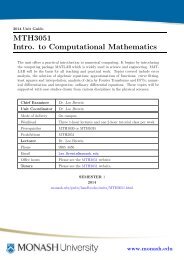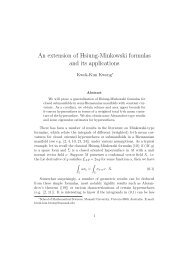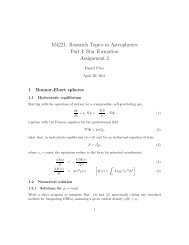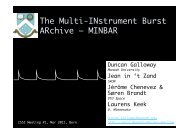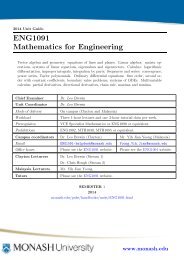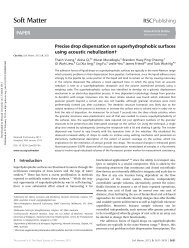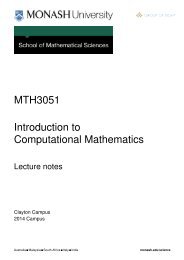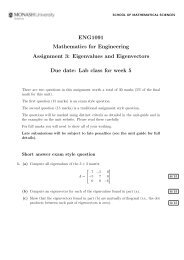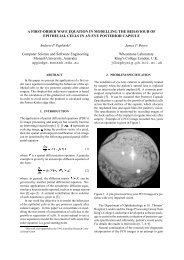Intersection theory on moduli spaces of curves ... - User Web Pages
Intersection theory on moduli spaces of curves ... - User Web Pages
Intersection theory on moduli spaces of curves ... - User Web Pages
You also want an ePaper? Increase the reach of your titles
YUMPU automatically turns print PDFs into web optimized ePapers that Google loves.
36 1. A gentle introducti<strong>on</strong> to <strong>moduli</strong> <strong>spaces</strong> <strong>of</strong> <strong>curves</strong>Now integrate with respect to L 1 and divide by 2L 1 to obtain the desired volume.V 1,2 (L 1 , L 2 ) = L4 1192 + L2 1 L2 296 + L4 2192 + π2 L 2 112 + π2 L 2 212 + π44= 1192 (L2 1 + L2 2 + 4π2 )(L 2 1 + L2 2 + 12π2 )A simple though important corollary <strong>of</strong> Mirzakhani’s recursi<strong>on</strong> is the following result.Corollary 1.31. The volume V g,n (L) is an even symmetric polynomial <strong>of</strong> degree 6g − 6 + 2n in theboundary lengths L 1 , L 2 , . . . , L n . Furthermore, the coefficient <strong>of</strong> L 2α 11L 2α 22. . . L 2α nn is a rati<strong>on</strong>al multiple<strong>of</strong> π 6g−6+2n−2|α| .The symmetry <strong>of</strong> V g,n (L) follows immediately from the symmetry <strong>of</strong> the boundary labels. Theremainder <strong>of</strong> the statement can be proven by inducti<strong>on</strong> <strong>on</strong> the negative Euler characteristic.That the Weil–Peterss<strong>on</strong> volumes are polynomials is a rather amazing fact. Actually, we willsee that the technique <strong>of</strong> symplectic reducti<strong>on</strong> can be used to prove that their coefficients storeinteresting informati<strong>on</strong>.Volumes and symplectic reducti<strong>on</strong>Symplectic geometry has its origins in the mathematical formulati<strong>on</strong> and generalisati<strong>on</strong> <strong>of</strong> thephase space <strong>of</strong> a classical mechanical system. 7 For a l<strong>on</strong>g time, physicists have taken advantage<strong>of</strong> the fact that when a symmetry group <strong>of</strong> dimensi<strong>on</strong> n acts <strong>on</strong> a system, then the number <strong>of</strong>degrees <strong>of</strong> freedom for the positi<strong>on</strong>s and momenta can be reduced by 2n. The analogous mathematicalphenomen<strong>on</strong> is known as symplectic reducti<strong>on</strong>. More precisely, c<strong>on</strong>sider a symplecticmanifold (M, ω) <strong>of</strong> dimensi<strong>on</strong> 2d with aT n = S 1 × S 1 × . . . × S 1} {{ }n timesacti<strong>on</strong> that preserves the symplectic form. Furthermore, suppose that this acti<strong>on</strong> is the Hamilt<strong>on</strong>ianflow for the moment map µ : M → R n and that 0 is a regular value <strong>of</strong> the moment map.Note that T n must act <strong>on</strong> the level sets <strong>of</strong> µ, so <strong>on</strong>e can defineM 0 = µ −1 (0)/T n .The main theorem <strong>of</strong> symplectic reducti<strong>on</strong> states that M 0 is a symplectic manifold <strong>of</strong> dimensi<strong>on</strong>2d − 2n with respect to the unique 2-form ω 0 which satisfies i ∗ ω = π ∗ ω 0 , where π : µ −1 (0) →M 0 and i : µ −1 (0) → M are the natural projecti<strong>on</strong> and inclusi<strong>on</strong> maps. In fact, since 0 is a7 For a reas<strong>on</strong>ably elementary introducti<strong>on</strong> to symplectic geometry, we recommend the text [7].



